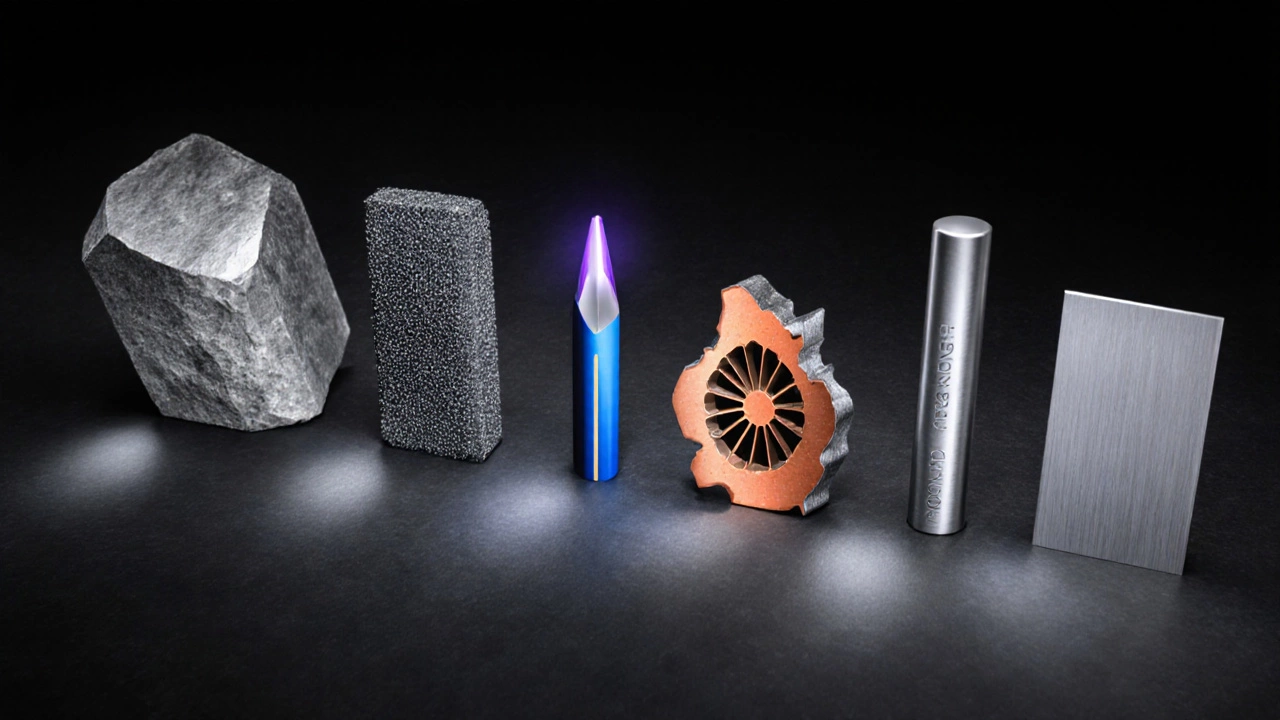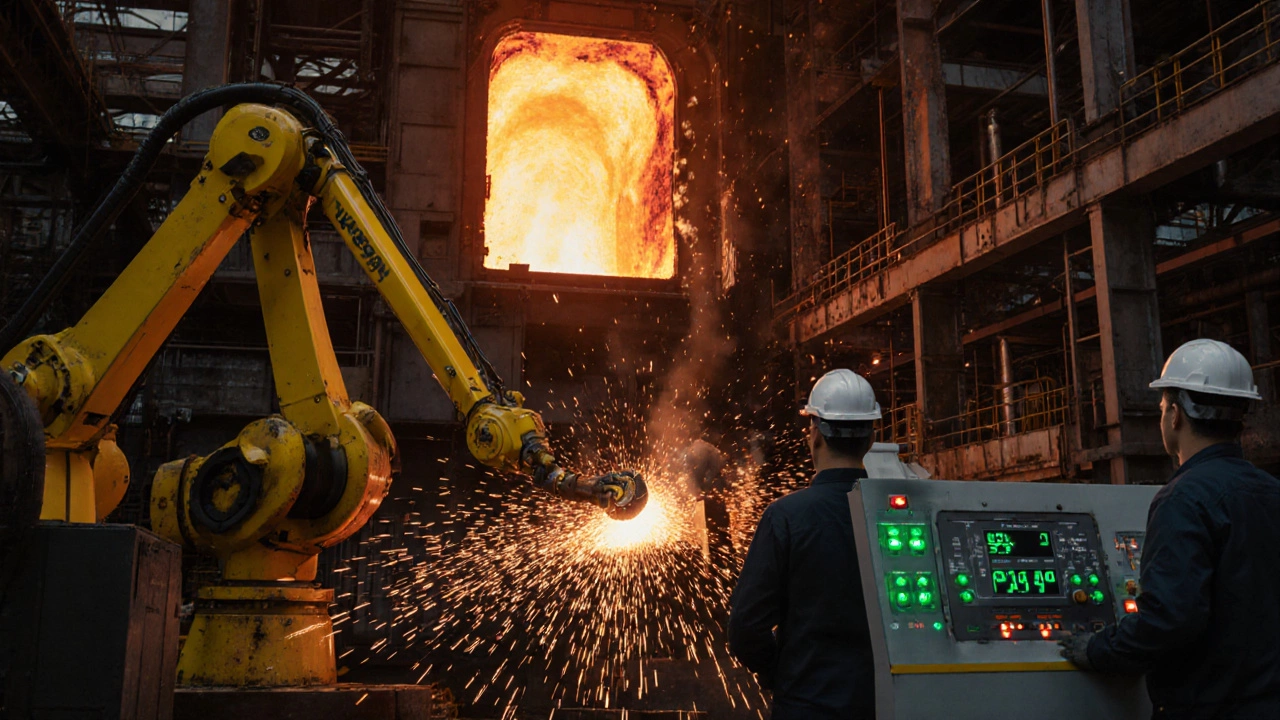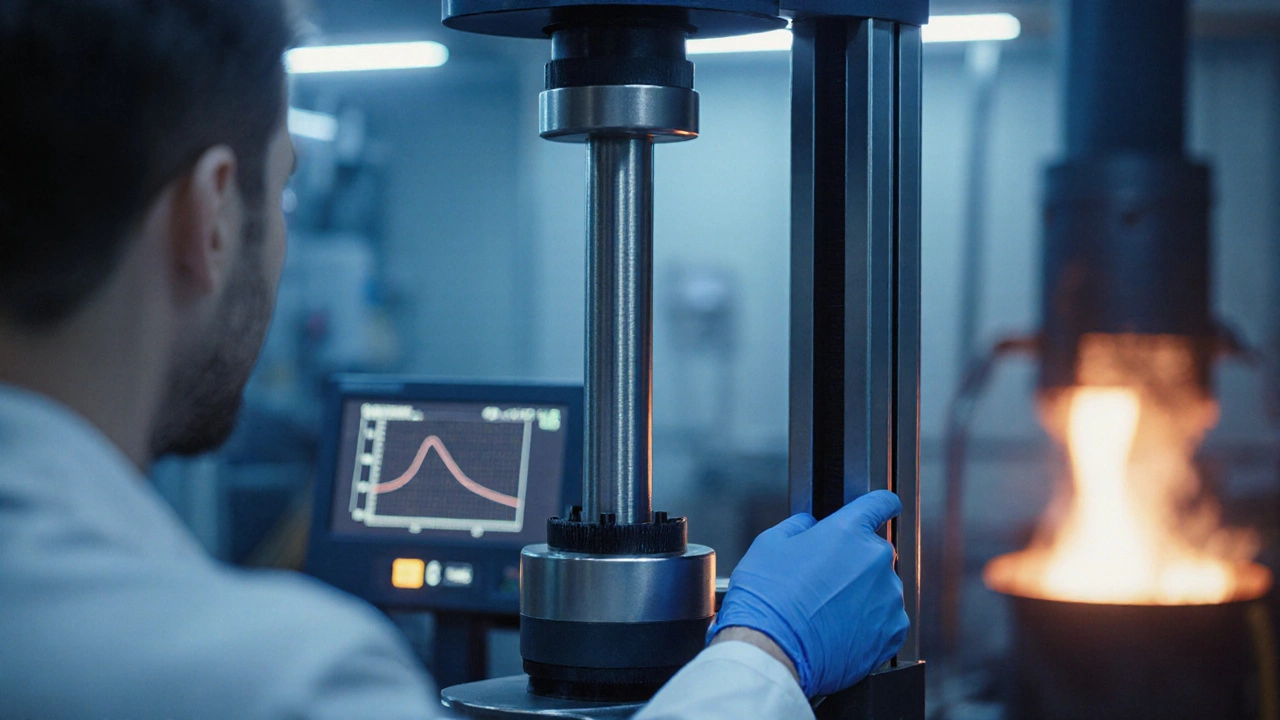Metal Strength Comparison Tool
Compare the strength properties of different metals and alloys. Use the filters to see metals with specific tensile strength ranges and view their key properties.
Filter by Tensile Strength (MPa)
When you hear the word strongest metal, you might picture a bulky bar of steel or a shiny alloy used in aerospace. In reality, the title belongs to a metal that combines extreme tensile strength, high melting point, and remarkable hardness-all while posing serious challenges for machining and forming. Below we break down what “strongest” really means, which metals actually claim the crown, and why the answer matters for anyone running a steel plant.
How Do We Measure Metal Strength?
Strength isn’t a single number; engineers look at three main properties:
- Tensile strength - the maximum stress a material can withstand while being pulled before it breaks, measured in megapascal (MPa).
- Yield strength - the stress at which a material begins to deform permanently.
- Hardness - resistance to indentation or scratching, often reported on the Vickers (HV) or Rockwell scales.
For most industrial applications, tensile strength is the headline figure because it predicts how a component will behave under load. However, hardness tells you how brittle a metal might be, and yield strength influences shaping processes like rolling or forging.
Top Contenders for the Strongest Metal
Below are the metals that repeatedly top the strength charts. Each entry includes a brief definition wrapped in Schema.org microdata so search engines can recognize the entities.
Tungsten is a refractory metal with the highest melting point of all pure metals (3,422°C) and a tensile strength around 1,510MPa. Its density (19.25g/cm³) makes it heavy, but that weight contributes to its exceptional hardness (up to 4,000HV) and wear resistance.
Tungsten carbide combines tungsten with carbon, forming a compound that reaches hardness levels above 2,500HV and tensile strengths exceeding 1,200MPa. It’s the go‑to material for cutting tools and drill bits because it holds an edge where pure tungsten would crumble.
Molybdenum sits just below tungsten on the strength scale, offering tensile strengths near 690MPa and a melting point of 2,630°C. Its primary value is in alloying, where it boosts the strength of steel without adding excessive brittleness.
Chromium is best known for rust resistance, yet it also contributes significantly to hardness when alloyed. Pure chromium reaches tensile strengths of about 850MPa and a melting point of 1,907°C.
Inconel is a nickel‑chromium superalloy that retains a tensile strength of roughly 1,200MPa at temperatures above 1,000°C, making it indispensable for turbine blades and high‑heat environments.
Maraging steel combines very low carbon with nickel, cobalt, and molybdenum, delivering tensile strengths up to 2,400MPa after heat treatment. Its name comes from “martensitic” + “aging”.
Titanium isn’t the strongest by raw tensile numbers (≈900MPa), but its high strength‑to‑weight ratio makes it a favorite in aerospace and medical implants.
Steel is a family, not a single metal. High‑strength low‑alloy (HSLA) steels and ultrahigh‑strength (UHS) steels can reach tensile strengths above 2,000MPa after tempering, but they typically fall short of tungsten’s hardness.
Side‑by‑Side Comparison
| Metal / Alloy | Tensile Strength (MPa) | Melting Point (°C) | Density (g/cm³) | Common Industrial Uses |
|---|---|---|---|---|
| Tungsten | 1,510 | 3,422 | 19.25 | Electrical contacts, radiation shielding |
| Tungsten carbide | 1,200 | 2,870 (compound) | 15.6 | Cutting tools, mining drills |
| Maraging steel | 2,400 | 1,500 (approx.) | 8.0 | Aerospace frames, high‑stress tooling |
| Inconel | 1,200 | 1,400 | 8.4 | Gas turbine blades, chemical reactors |
| Steel (UHS) | 2,100‑2,400 | 1,460 | 7.8 | Automotive bodies, construction beams |
| Titanium | 900 | 1,660 | 4.5 | Aerospace skins, medical implants |

Why Steel Manufacturers Care About the Strongest Metal
Even if you never plan to melt a chunk of tungsten in your furnace, the properties of the world’s strongest metal influence steel production in three ways:
- Alloying potential: Adding small amounts of tungsten or molybdenum to steel dramatically raises high‑temperature strength, essential for heavy‑duty rails and drill‑pipe steel.
- Tooling benchmarks: Cutting, grinding, and polishing tools are often made from tungsten carbide because it outlasts steel tools. Knowing its limits helps you schedule tool‑change intervals and reduce downtime.
- Process design: Forging or rolling temperatures must stay below the melting point of the hardest phases present. When you introduce tungsten‑based alloys, you may need to tweak furnace schedules to avoid excessive grain growth.
In short, the strongest metal sets the performance ceiling for many downstream steel products, and understanding it lets you push that ceiling further.
Handling and Processing Tips for High‑Strength Metals
Working with metals that sit at the top of the strength chart isn’t a walk in the park. Here are some practical pointers for plant managers and line engineers:
- Machining: Use carbide inserts and high‑pressure coolant. Tungsten carbide tools can handle speeds up to 250m/min, but you’ll still need slower feed rates to avoid tool chatter.
- Heat treatment: For maraging steel, the aging step at 480‑500°C for 3-8hours creates the fine intermetallic precipitates that give the material its ultra‑high tensile strength.
- Welding: Pre‑heat tungsten‑alloyed steels to 250°C to reduce cracking, and use filler metals with matching alloying elements to maintain strength.
- Inspection: Ultrasonic testing and eddy‑current scans are more reliable than visual checks for detecting micro‑cracks in extremely hard alloys.

Key Takeaways
- While many metals are strong, pure tungsten tops the list for tensile strength and hardness.
- Alloying tungsten or using ultra‑high‑strength steels (like maraging steel) can bring tensile values above 2,000MPa.
- Steel manufacturers benefit from these metals through tougher alloys, longer‑lasting tooling, and refined heat‑treatment cycles.
- Processing high‑strength metals requires specialized machining tools, careful heat‑treatment, and rigorous inspection.
- Understanding the exact metrics (tensile, yield, hardness) helps you choose the right material for each application.
Frequently Asked Questions
Is tungsten the strongest metal in every sense?
Tungsten leads in tensile strength and hardness among pure metals, but some engineered alloys-like maraging steel or certain nickel‑based superalloys-can surpass it in tensile strength. The definition of “strongest” depends on the metric you prioritize.
Can I add pure tungsten to my steel melt?
Directly adding pure tungsten is difficult because of its extremely high melting point. Instead, steelmakers use tungsten carbide or pre‑alloyed powders that dissolve more readily during secondary melting.
What safety concerns exist when machining tungsten carbide?
Carbide dust is hazardous if inhaled, so use local exhaust ventilation and wear respirators. Also, the material can cause tool wear on the machine itself, so schedule regular spindle inspections.
How does density affect the choice of a strong metal?
Higher density means more weight for the same volume, which can be a drawback in transportation‑heavy applications like aerospace. Engineers often trade off density for strength‑to‑weight ratio, choosing titanium or aluminum‑lithium alloys when weight matters.
Are there any recent breakthroughs in ultra‑strong metals?
Additive manufacturing (3D printing) of metal powders has enabled gradient alloys that combine a tungsten‑rich core with a more ductile skin, delivering high surface toughness while keeping core strength. Researchers in 2024 reported a printed alloy with 1,800MPa tensile strength and 30% lower brittleness.
